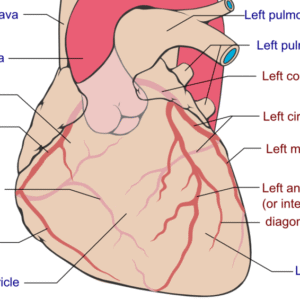Cardiology > Atrial Myxoma
Atrial Myxoma
Background
Atrial myxoma is the most common primary benign cardiac tumor, typically arising from the interatrial septum in the region of the fossa ovalis, usually within the left atrium. Composed of myxoid (gelatinous) tissue, myxomas are pedunculated and can prolapse into the mitral valve orifice, mimicking mitral stenosis or causing embolic phenomena. Though benign, atrial myxomas can be life-threatening due to obstructive and embolic complications.
II) Classification/Types
By Location:
- Left atrial myxoma (80%) – Attached to the fossa ovalis; most symptomatic
- Right atrial myxoma (15–20%) – May mimic tricuspid valve disease
- Ventricular myxoma (rare) – Associated with worse hemodynamic compromise
By Morphology:
- Pedunculated: Most common; mobile mass with stalk
- Sessile: Broad-based and less mobile
By Clinical Pattern:
- Sporadic: Most cases, typically in middle-aged females
- Familial: Autosomal dominant (Carney complex), younger age, multiple or recurrent tumors
Pathophysiology
Atrial myxomas obstruct blood flow by prolapsing through the mitral or tricuspid valve during diastole, causing symptoms similar to valve stenosis. Fragments may embolize to the brain, limbs, or other organs. Additionally, myxomas can secrete inflammatory cytokines (e.g., interleukin-6), causing systemic constitutional symptoms like fever and malaise. Their gelatinous, friable nature predisposes to embolization.
Epidemiology
- Atrial myxomas account for ~50% of primary cardiac tumors in adults
- Predominantly occur in women aged 30–60 years
- Sporadic cases are more common than familial
- Familial cases are associated with Carney complex and may present earlier with multiple lesions
Etiology
I) Causes
- Sporadic mutation in endocardial mesenchymal cells
- Familial cases: Associated with Carney complex (PRKAR1A gene mutation), which may include lentigines, endocrine tumors, and schwannomas
II) Risk Factors
- Positive family history (Carney complex)
- Female sex
- Age 30–60 for sporadic cases
- Childhood and adolescence in familial forms
Clinical Presentation
I) History (Symptoms)
- Dyspnea, orthopnea: From mitral valve obstruction
- Syncope or presyncope: Intermittent obstruction of mitral inflow
- Palpitations or chest pain
- Embolic events: Stroke, limb ischemia, retinal artery occlusion
- Systemic symptoms: Fever, weight loss, malaise from cytokine release
II) Physical Exam (Signs)
- Diastolic murmur at apex that changes with position
- “Tumor plop” sound: Early diastolic sound heard best in left lateral position
- Signs of systemic embolization: Focal neurologic deficits, skin changes
- Features of heart failure in severe obstruction
Differential Diagnosis (DDx)
- Mitral stenosis (rheumatic or congenital)
- Intracardiac thrombus
- Infective endocarditis
- Cardiac metastases or other tumors
- Atrial septal aneurysm
- Left atrial ball thrombus (in AF)
Diagnostic Tests
Initial Evaluation
- ECG: Nonspecific; may show left atrial enlargement or atrial arrhythmias
- Chest X-ray: May show cardiomegaly or pulmonary edema
- Transthoracic echocardiography (TTE): First-line imaging; identifies size, mobility, and location
- Transesophageal echocardiography (TEE): Superior for defining attachment site, mobility, and tumor features
Advanced Imaging
- Cardiac MRI or CT: Used for tissue characterization, differentiating thrombus from tumor, preoperative planning
- Histopathology: Confirmatory; surgical resection specimen shows stellate or polygonal myxoma cells in myxoid stroma
- ESR/CRP/IL-6: May be elevated due to cytokine production
Treatment
I) Acute Management
- Hospital admission for symptomatic or embolic myxoma
- Stabilize cardiac function if signs of heart failure
- Anticoagulation if embolic risk present, although surgery is definitive
II) Chronic Management
- Surgical excision is the treatment of choice and should be performed promptly due to risk of embolization or sudden death
- Repair of atrial septal defect often needed after excision
- Monitor for recurrence, especially in familial cases
Medications
Drug Class | Examples | Notes |
Anticoagulants | Warfarin, Apixaban | For pre-op embolic protection if indicated |
Anti-inflammatory | NSAIDs | For constitutional symptoms if present |
Diuretics | Furosemide | For symptomatic relief in heart failure |
Device Therapy
- No specific device therapy unless complications (e.g., arrhythmias requiring pacemaker)
- TEE or MRI surveillance devices used during long-term follow-up
Patient Education, Screening, Vaccines
- Educate on signs of recurrence (dyspnea, stroke-like symptoms)
- Familial screening if Carney complex suspected
- Encourage early medical evaluation for new symptoms
- Influenza and pneumococcal vaccines if heart failure is present
Consults/Referrals
- Cardiothoracic surgery: For tumor resection
- Cardiology: For workup and follow-up of structural effects
- Neurology: For embolic complications (e.g., stroke)
- Genetics: If Carney complex or multiple tumors present
Follow-Up
Short-Term
- Post-op monitoring for arrhythmias, infection, or pericardial effusion
- Echocardiography before discharge and at 1–3 months
Long-Term
- Annual TTE or MRI to monitor for recurrence
- Family screening in hereditary cases
- Monitor for embolic complications, especially if patient delays surgery
Prognosis
- Excellent after complete surgical resection in sporadic cases (recurrence <5%)
- Higher recurrence risk in familial myxomas or incomplete excision
- Sudden death risk if untreated due to embolism or obstruction
- Prompt diagnosis and surgery ensure near-total resolution of symptoms and prevent complications
Stay on top of medicine. Get connected. Crush the boards.
HMD is a beacon of medical education, committed to forging a global network of physicians, medical students, and allied healthcare professionals.

